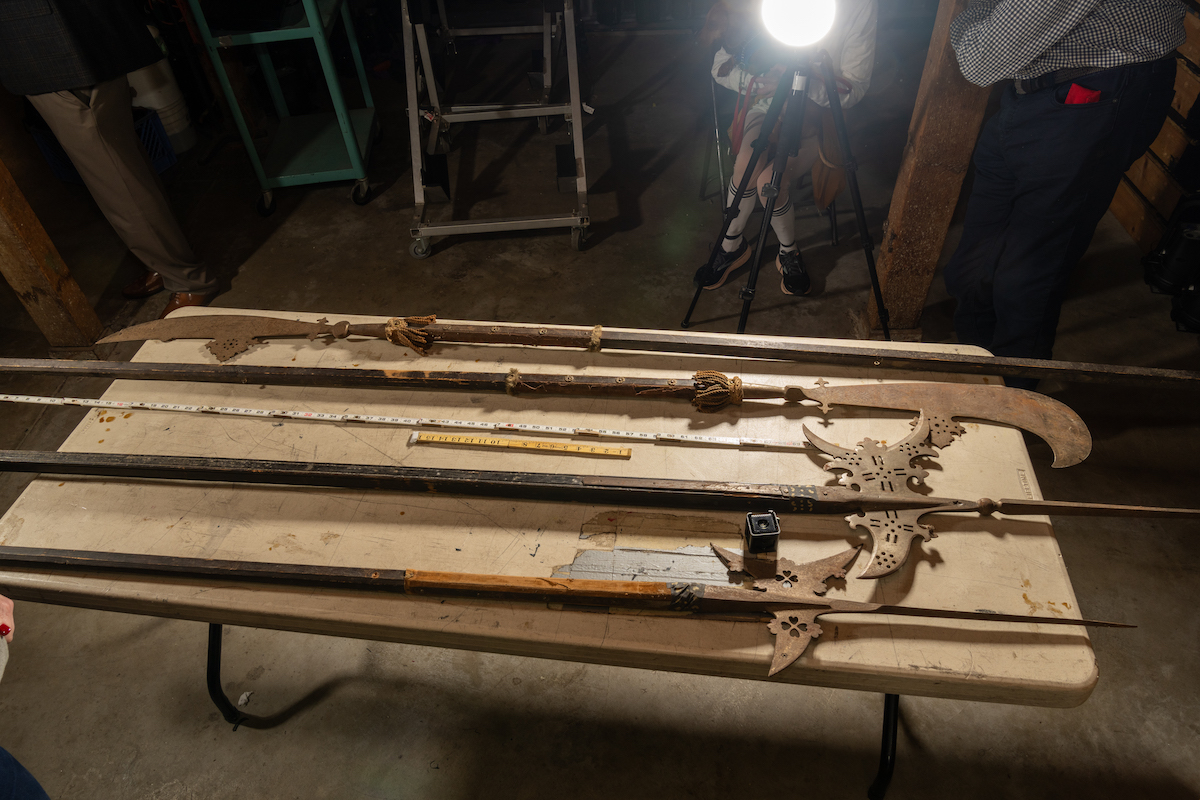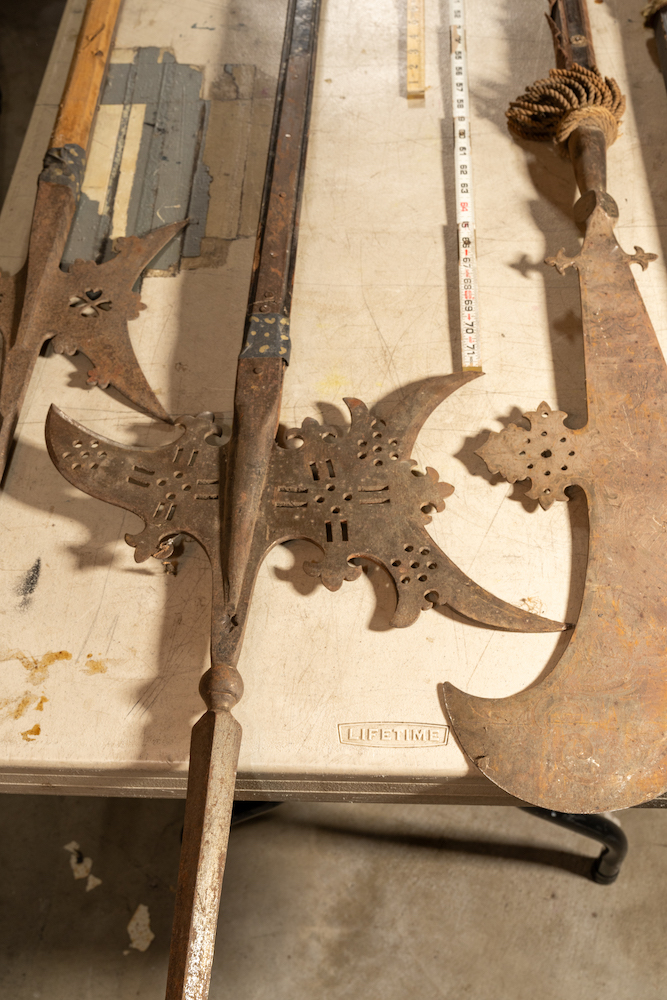The Lobero Polearms

The audience waiting on the steps of the Lobero Theatre on the Sunday night of December 9, 1957, were hip jazz lovers, some from the College Jazz Club, sponsors of the concert, all eager for the night’s concert. The legendary master of the vibes and the bongos, Cal Tjader, would be performing “hot numbers” (as quoted in the Santa Barbara News-Press of December 1, 1957), his mambos and “cha cha chas” with his four jazzmen. The Lobero had become a jazz destination since the 1953 performance by Dave Brubeck and his All Stars; Tjader was an alumnus of Brubeck and the George Shearing Ensemble. So instrumental was the Lobero in developing the “West Coast” style of jazz that the theater became a venue beloved by jazz artists such as Dizzy Gillespie, Herbie Hancock, Betty Carter, Shirley Horn, and Sarah Vaughan. Having paid between $1.50 and $2.50 per ticket, the audience took their seats: It may have been a full house.
In that audience lurked a thief. After the concert, a fine collection of four late medieval 8-10 ft. long combat weapons, décor on the main lobby wall, would be down to three; the discovery was made by the theater manager Dorothy Fenzi as she shut down the House. Someone walked out of that concert hoisting a ferocious spiked and bladed iron weapon on a hefty wooden pole. The four displayed weapons are known as polearms: there had been two halberds, weighty and terrifying iron spikes at 20”, with blades and flukes, and two scimitar-like fauchards; curved 14” blades with gaffers to the back. The wall bearing these fierce cousins to medieval spears and lances was seen immediately upon entering the Lobero. After the concert in 1957, the wall displayed only an empty space.

Theater manager Fenzi had likely seen the pole arms daily from 1949 or 1950 (she stated the weapons had been donated in 1949 or 1950 in a reported interview with the police that night). Their location on display at the theater would have given us a clue as to their significance and use: perhaps the theatre staff had considered them important enough to hang on the entry wall that today holds the famed 84-inch wide Lobero Golden Eagle. Possibly the polearms with their medieval iron were considered appropriate décor for the 1924 Spanish Colonial style architecture of the Lobero, designed by George Washington Smith and Lutah Maria Riggs.
Fenzi was interviewed by the Santa Barbara News-Press of December 10, 1957. Testimony to 1950s American naiveté, Dorothy Fenzi is quoted as saying that she hoped that whoever had taken it would return it after he (sic) learns its real value. The article states that the “lances” were described as 16th century.
Miraculously Fenzi’s wish came true: a subsequent story in the newspaper of December 12, 1957 reports that Fenzi, on Thursday night, found the weapon propped up against the back wall of the theater. The paper quotes Fenzi as assuming the return was occasioned because the weapon had become “too hot to handle.” Thus, the four polearms were reunited, although they may not have been remounted on that lobby wall for fear of further thefts. To this day, they live together at the Lobero.
Brett Hodges, board member and historian of the Lobero was kind enough to invite me to opine on the authenticity of the weapons, located for at least the last 40 years (a longtime employee remembers them when he was hired) in the mysterious basement bowels of the theater. During my visit, staff members offered opinions on their purpose. Some believed they may be props originally donated in 1949/50 for a specific medieval history play. But they are heavy, sharp, and dangerous, unwieldy on stage, and as Fenzi is quoted after the theft, of significant value. Perhaps they were thought to be too precious (and too deadly) for a stage fight.
Props are not often displayed as rare art: they had hung in pride of place in the Lobero lobby for at least seven or eight years since their donation. The four polearms may have had a stage debut as props and then were displayed: even Shakespeare’s plays feature medieval style weaponry; his cryptic stage directions of “they fight” often called for props such as short swords, rapiers, cudgels, daggers, poniards, and bastard swords.
I often discover syncretic relationships between people, places, and objects. Polearms like these halberds and fauchards have a connection to Genoa, Italy, the birthplace in 1823 of Giuseppe Lobero. For this reason, they may have been a gift from a knowledgeable donor to the Lobero. Even though Lobero had died in 1892, his memory (and ghost) may have prompted a donor to honor him. Was “Joe” Lobero’s history known in the 1950s? Yes. At the date of the theft, Lobero was on his way to getting his “propers”. As Lobero was in repose in an unmarked grave, on May 5, 1962, a civic minded community group paid for and installed a gravestone for “Joe” (Giuseppe) at the Santa Barbara Cemetery.
Back to the Genoese connection: the Genoese Navy began to use a type of halberd called a Sergentina in the 16th century and still carry the polearm in ceremonies today. And the Genoese Navy is one of a few organizations displaying the weapon, as do the Papal Swiss Guards, and the British Yeomen of the Guards. Perhaps a patron of the theater once visited Northern Italy and purchased these four polearms and thought them to be an appropriate gift to the theater and its long dead but not forgotten founder.
What are they worth? Yes, they are antiques. I believe at least two of them are authentic to the 16th century. Does their age at 450 years make them valuable? If two were reproductions would that affect value? Yes, they are perhaps rare because of their age(s), and perhaps rare because even as a ceremonial object they symbolize a rare appearance – and rarity influences value. But there’s a limited market for these weapons, 16th century, 19th century, or otherwise.
The fact that they are aggressive killing machines may influence the lack of market. I describe the halberd as having a robust 20” central spike, and an axe blade for chopping through armor when swung. On the other side of the blade is a hook called a fluke, all in cast iron and mounted on a 8 ft. wood pole with a square haft, the blades pierced with a cross and arch motif. The fauchards have a 14” curved blade which is chased (a form of decorative indentation) with a figure in Roman armor and a date of 1587, the other with a heraldic coat of arms with a spread eagle dated 1571. On the other side of the cutting edge, there are lance points attached to the back as a dagger, in steel, on an 8 ft. pole. They are simple and blatantly fierce. During the late medieval period, weapons were unsophisticated, and the Church forbade any weapon to be used that was not mentioned in the Bible. Thus, the sophisticated arms of ancient Rome were not employed, and it is for this reason that I believe the two fauchards to be 19th century ceremonial reproductions. A weapon made for battle in the 16th century would not have been dated nor have been ornately chased with a Roman soldier.
Two halberds may be 16th century and are worth $850 each, and the two fauchards may be 19th century ceremonial reproductions and are worth $450 each. I contacted the auction house famous for sales of antique weapons and arms, the San Giorgio Aste, coincidentally located in Genoa, Italy. Similar pole arms sell for between 400 and 800 euros.




